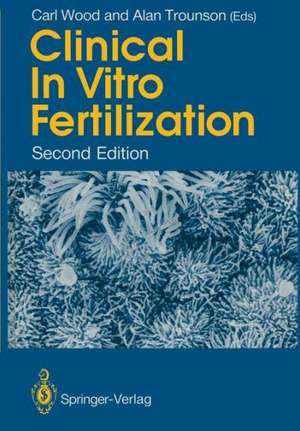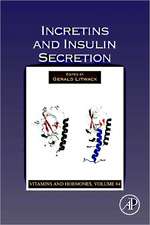Clinical In Vitro Fertilization
Editat de Carl Wood, Alan Trounsonen Limba Engleză Paperback – 20 noi 2011
Preț: 364.33 lei
Preț vechi: 383.50 lei
-5% Nou
Puncte Express: 546
Preț estimativ în valută:
69.72€ • 72.52$ • 57.56£
69.72€ • 72.52$ • 57.56£
Carte tipărită la comandă
Livrare economică 15-29 aprilie
Preluare comenzi: 021 569.72.76
Specificații
ISBN-13: 9781447116660
ISBN-10: 1447116666
Pagini: 188
Ilustrații: XVI, 166 p.
Dimensiuni: 170 x 244 x 10 mm
Greutate: 0.31 kg
Ediția:2nd ed. 1989. Softcover reprint of the original 2nd ed. 1989
Editura: SPRINGER LONDON
Colecția Springer
Locul publicării:London, United Kingdom
ISBN-10: 1447116666
Pagini: 188
Ilustrații: XVI, 166 p.
Dimensiuni: 170 x 244 x 10 mm
Greutate: 0.31 kg
Ediția:2nd ed. 1989. Softcover reprint of the original 2nd ed. 1989
Editura: SPRINGER LONDON
Colecția Springer
Locul publicării:London, United Kingdom
Public țintă
ResearchCuprins
1 Selection and Preparation of Patients for In Vitro Fertilization.- 1.1 Introduction.- 1.2 The Waiting List.- 1.3 Length of Menstrual Cycles — Confidence Limits.- 1.4 Hormonal Assessment.- 1.5 Assessment of Semen.- 1.6 Serological Assessment.- 1.7 Bacteriological Assessment of the Cervix.- 1.8 Assessment of the Pelvis Prior to Treatment.- 1.9 Consent Forms.- 1.10 Psychological Preparation.- 1.11 Patient Support Group.- 2 Patient Management.- 2.1 Introduction.- 2.2 Natural Folliculogenesis.- 2.3 Stimulated Follicular Development.- 2.4 Conclusion.- 3 Oocyte Pick-up.- 3.1 Introduction.- 3.2 Laparoscopic Method.- 3.3 Ultrasound-Guided Techniques.- 3.4 Ultrasound-Guided Technique Using a Combined Vaginal Needle and Transducer.- 3.5 Results.- 3.6 Conclusions.- 4 Fertilization and Embryo Culture.- 4.1 Introduction.- 4.2 Quality Control of Laboratory Procedures.- 4.3 Media for Insemination of Eggs and Culture of Embryos.- 4.4 Culture Conditions and Methods.- 4.5 Evaluation of Eggs.- 4.6 Insemination of Eggs.- 4.7 Microfertilization Techniques.- 4.8 Evaluation of the Fertilization Process.- 4.9 Evaluation of Embryos.- 4.10 Conclusions.- 5 Results from In Vitro Fertilization.- 5.1 The Evaluation of Results H. W. Jones Jr.- 5.2 Results P. A. W. Rogers.- 6 Gamete Intra-fallopian Transfe.- 6.1 History.- 6.2 Gamete Preparation.- 6.3 Gamete Transfer.- 6.4 Results.- 6.5 Complications.- 7 Outcome of Pregnancy.- 7.1 Introduction.- 7.2 Characteristics of Infertile Couples.- 7.3 Overall Results of IVF Pregnancies.- 7.4 Early Pregnancy Losses.- 7.5 Viable Pregnancies.- 7.6 Infants Born after In Vitro Fertilization.- 7.7 Conclusions.- 8 Andrology, Male Factor Infertility and IVF.- 8.1 Introduction.- 8.2 Assessment of the Male.- 8.3 Separation of Motile Sperm.- 8.4 Male FactorInfertility.- 9 Oocyte Freezing.- 9.1 Introduction.- 9.2 The Human Oocyte.- 9.3 Feasibility of Oocyte Cryopreservation.- 9.4 Cryobiological Concepts in Oocyte Cryopreservation.- 9.5 Developing Oocyte Freezing Using an Animal Model.- 9.6 Establishing Human Oocyte Freezing.- 9.7 Factors Influencing Successful Freezing.- 9.8 Results of Human Oocyte Cryopreservation.- 9.9 Discussion.- 10 Embryo Cryopreservation.- 10.1 Introduction.- 10.2 Requirements for Embryo Freezing.- 10.3 Development of Slow Cooling Methods for Cryopreserving Human Embryos.- 10.4 Methods of Cryopreservation by Slow Cooling.- 10.5 Success of Cryopreservation by Slow Cooling.- 10.6 The Development of Rapid Cooling Methods for Cryopreservation.- 10.7 Use of Rapid Freezing Methods for Cryopreservation of Human Embryos.- 10.8 Cryopreservation of Embryos and Unfertilized Oocytes.- 10.9 Conclusion.- 11 Oocyte Donation.- 11.1 Introduction.- 11.2 Indications for Donor Oocytes.- 11.3 Clinical Management.- 11.4 Source of Donor Oocytes.- 11.5 Steroid Replacement Therapy.- 11.6 Uterine Receptivity for Implantation.- 11.7 Endocrinology of Pregnancy.- 11.8 Legal Aspects.- 12 Infertility Counselling.- 12.1 Introduction.- 12.2 Why Would Anyone Seek or Need Specialised Infertility Counselling.- 12.3 Is Counselling Synonymous with “Assessment”.- 12.4 Who Does the Counselling.- 12.5 What Are Common Expressions Indicating Consideration of a Counselling Referral.- 12.6 When is Infertility Counselling Appropriate.- 12.7 Should Counselling Be Compulsory for All Couples Seeking IVF.- 12.8 Are There Particular Treatment Options Necessitating Prior Counselling.- 12.9 What Are the Particular Issues a Counsellor Would Discuss with Couples Contemplating the Use of Donor Gametes.- 12.10 What is the Counselling Role of SupportGroups.




















